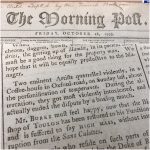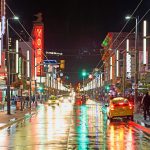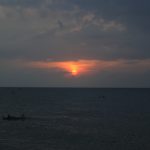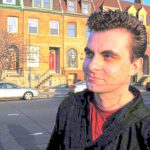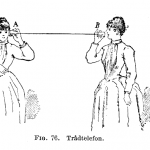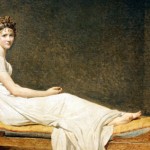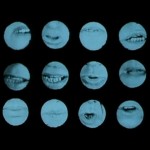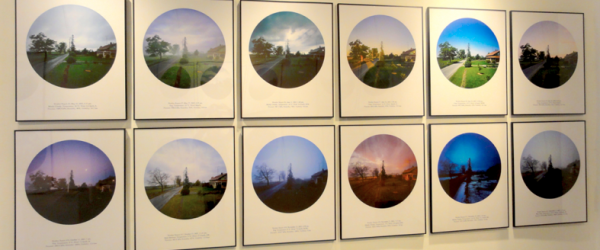
Documenting The Weather & The Woods
Art, Art NewsNew works by Andrzej Maciejewski and Michael Farnan
Location-specific works can manage a definition built on inquisition and awareness. Knowing the exact destination or understanding its whereabouts prescribes a context and this context can be used to help validate meaning, or at the very least create conversation about that meaning.

Two works – completely different in concept – are in focus: ‘Weather Report’ by Andrzej Maciejewski and two video works entitled ‘The Beaver goes Logging’ and ‘The Legend of Bison Hughy’ by Michael Farnan. Where one story creates a narrative on “becoming animal” the other explores saturations of the ordinary. Where one drives attention to a stream of evolving spatial conditions, the other begs the clasp of the unknown.
Andrzej Maciejewski
Weather Report presents a series of thirty-six views of the same place, taken in Moscow, Ontario. Over the course of one year Andrzej Maciejewski photographed the location (his former home) heavily aware of the composition and landscape spectrum. One will notice the colours of the sky, the relationship between objects and land, the consistency, but lack of certainty that comes when observing the weather. “I have always been attracted to documenting ordinary or everyday things. This is an exciting challenge for an artist, especially for a photographer, to work with a common object or phenomenon and to make it interesting for viewers” he explains.

While most focus on the terrain, in some photographs urban indicators such as a school bus become present, highlighting routine and time of day. In others it’s the haze of the fog, the growth and fading of sunflowers, the candor of the night or the luminosity of the light that makes one spot variations in landscape. At the bottom of each photograph Maciejewski details factors such as the temperature, the date, the wind and humidity, charting the location to its environment and the captured snapshots.
“All of us experience, every day, the phenomenon pictured in this series. Even in the city, you may still observe how the weather affects the look of the things around you. But usually it escapes our attention – and with photography these different everyday views may be brought together and compared and one may see how amazing it really is.”
Michael Farnan
Michael Farnan’s video works first vary in how each narrative is expressed. The Bison Hughy video is direct and breeds a documentary-styled approach to storytelling. “I find the hardest thing is taking an idea you have and then actually completing it” he explains.

The Beaver goes Logging video may indeed seem directional yet it “relies on the visual sight gag of seeing a logger put on a beaver suit to tell its story.” The story builds on reactionary means and having an intended beaver that is actually an adult surely creates a story in itself. Both videos were shot in the Fall of 2010. The narrative can also hold grave weight when it is true, which is the case with Bison Hughy. Although some of the parts of the video have been recreated, it is the authenticity of the area in Northern Saskatchewan and it is also the digestion that this person was actually charged by a bison that makes the story compelling to watch. Like Bison Hughy said, “If you are going to die, then what better way for a guy from the prairies to die than being charged by a bison?”
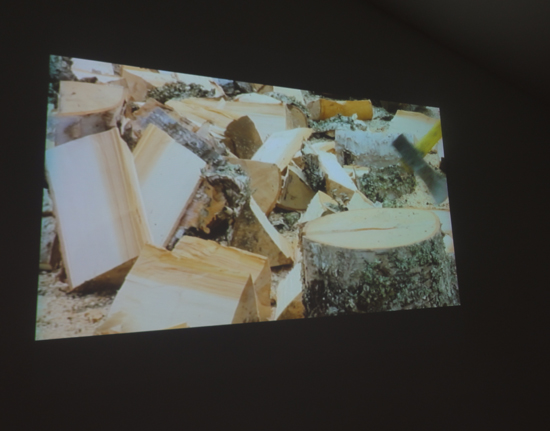
Farnan was conscious of having real people tell real stories through a wash of necessary prop staples (chainsaw, wood, trees). “I like that the actors are so authentic you can’t really tell where Hugh’s story stops and mine begins,” explains Farnan. The videos were originally conceived to be part of a twenty-minute multi-channel video installation and then were subsequently edited down to single works. “I think each of the videos consist of similar themes of “becoming animal” through an exploration of romantic ideas of the sublime and iconic images of ‘authentic’ Canadian identity.” In both exhibitions each artist has played with site-specific environments, but varied in the way these environments have been captured and reinvented.






